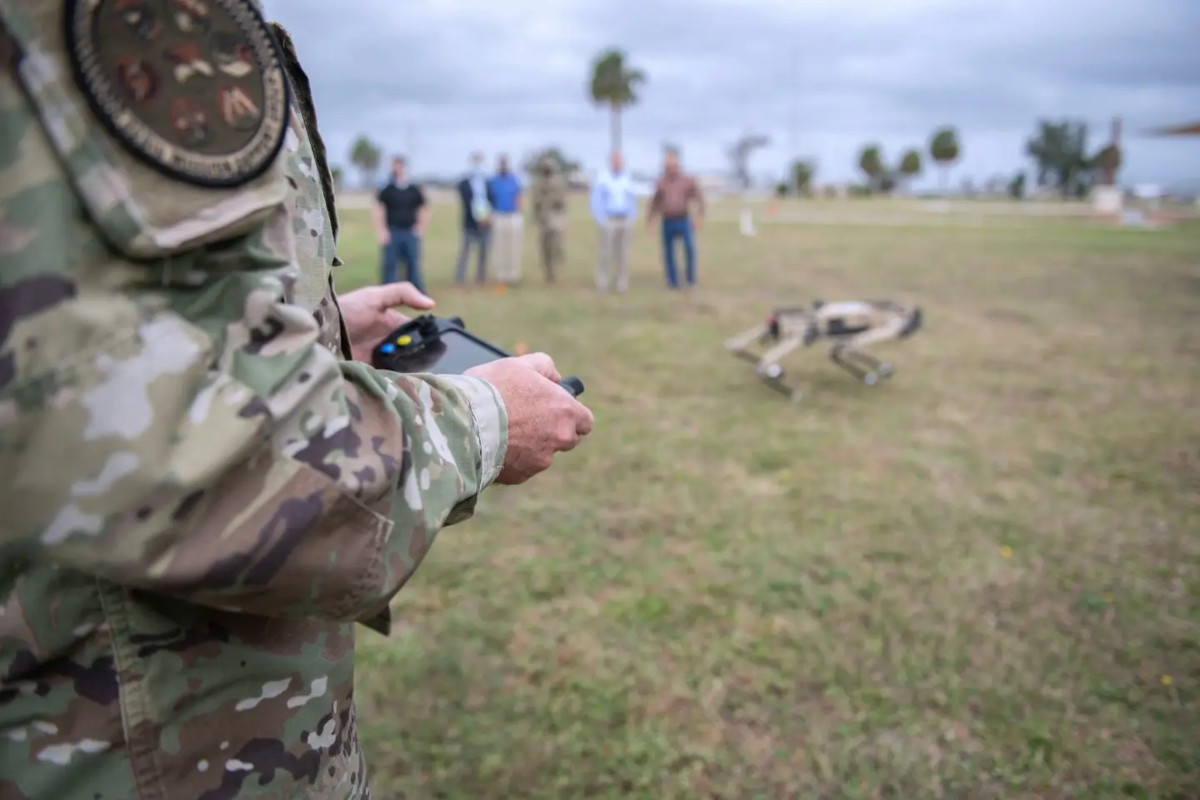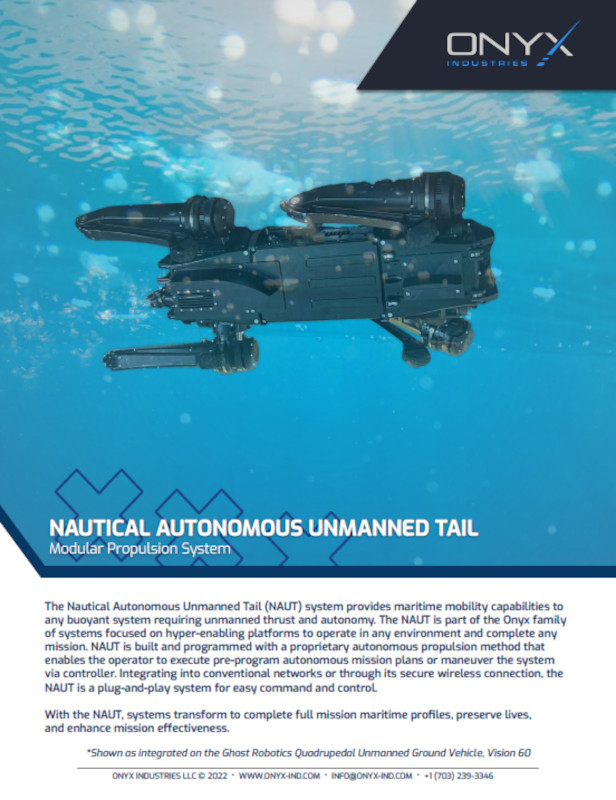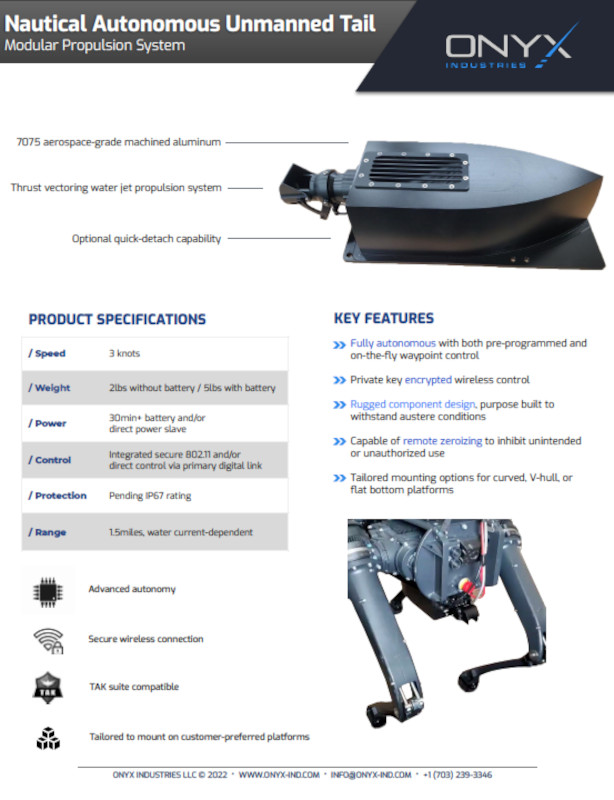Ghost Robotics’ has long touted its Vision 60 quadrupedal unmanned ground vehicles, or Q-UGVs, more commonly referred to as robot dogs, as eminently modular platforms that are readily adaptable to a wide array of roles, including as rifle-armed scouts. Now, thanks to a ‘tail’ kit with a water jet propulsion system from Onyx Industries, the company has added the ability to swim to the Vision 60’s list of capabilities.
The Onyx Industries‘ Nautical Autonomous Unmanned Tail (NAUT) makes the Vision 60, versions of which are already in U.S. military service, the first fully amphibious Q-UGV on the market, according to Ghost Robotics. “The robot [the Vision 60-series] has helped the military, law enforcement, and enterprise customers on land and now with the addition of Nautical Autonomous Unmanned Tail (NAUT) … it can help in water as well,” text accompanying a short video presentation that the company posted on social media, seen below, says.
Performance and other capability details about NAUT-equipped Vision 60s, such as how fast they can swim or what their maximum in-water endurance might be, do not appear to be readily available. The War Zone has reached out to both Ghost Robotics and Onyx Industries for more information.
“Battery life is a key issue. Eventually, we’re going to give it gait and motion so it can swim,” Ghost Robotics’ founder Jiren Parikh, who sadly died in March, had told The War Zone in 2020 in regards to potential future use of Vision 60s in a littoral environment. “We’ve filed some patents. It’s pretty cool.”
It’s worth noting that the Vision 60 equipped with the NAUT system does not appear to use its four legs while in the water in any way, relying entirely on the rear-mounted articulating water jet for propulsion and steering.
Thanks to a post on LinkedIn from Onyx, we do know that the complete NAUT unit includes a semi-autonomous control system that also enables an operator to control the Q-UGV manually from a remote position. Ghost Robotics has already demonstrated similar capabilities on non-amphibious Vision 60s, as you can read more about in this past War Zone feature.

“The NAUT jet propulsion unit transforms any IP67 or above rated platform, from robotics to small water craft, into a remotely piloted and/or autonomously enabled system,” according to Onyx. IP67 refers to a particular rating level in the internationally-accepted Ingress Protection (IP) code, which covers how protected electronics and other electrical systems might be against water, as well as other things, getting inside. The first and second numbers in the rating system refer to separate levels of protection, with the 6 in IP67 meaning that the system in question is fully sealed against dust, while the 7 means it has survived temporary immersion in water at a depth of between just under six inches (15 centimeters) and just over 3 feet (1 meter) in a test last approximately 30 minutes.
Regardless, the amphibious capability that the NAUT provides opens up a variety of possibilities for how a Vision 60 might be employed in support military operations, law enforcement activities, or in other roles. Vision 60s have demonstrated an ability to walk through shallow water, but the ability to cross deeper water obstacles can only increase their flexibility no matter what missions they might be tasked with.

For example, in a military context, this could give even a relatively small unit a way to scout out the situation on the opposite shore of a body of water, such as a river or lake, before attempting to cross. A NAUT-equipped Vision 60 might potentially be able to determine a safe path through a water obstacle, which could contain mines or other hazards, as well. These same attributes could be useful in a more general reconnaissance scenario, opening up additional routes that one of these Q-UGVs could take to the target area, potentially helping it avoid detection.
Onyx Industries had NAUT on display at this year’s Special Operations Forces Industry Conference (SOFIC), an annual event hosted by the National Defense Industry Association (NDIA) in Tampa, Florida. This highlights the potential value of this combination in support of various special operations forces missions, such as ‘special reconnaissance‘ deep behind enemy lines and direct action raids.

“We could potentially use it to sit there, maybe move it, maybe blow something up, or sense something on a riverbed or shoreline,” Parikh, the late Ghost Robotics founder and CEO, had also explained in 2020 when talking about potential military applications for the Vision 60.
A Vision 60 fitted with a NAUT would have value for supporting law enforcement personnel and other first responders, especially in disaster response scenarios where they might be presented with flooded-out areas full of unknown hazards, as well.
Whatever the case, NAUT does certainly underscore the modularity of the Vision 60 platform and Ghost Robotics’ continued partnership with numerous other companies to help outfit these Q-UGVs to be able to perform a host of missions. Now, with these new ‘tails,’ these robot dogs will be able to bring at least some of these capabilities out onto the water.
UPDATE: 6/14/2022 —
Onyx Industries has now provided The War Zone with some additional details about the NAUT and its capabilities when integrated with Ghost Robotics’ Vision 60 Q-UGV. The system is capable of propelling the robotic dog and speeds up three knots and can operate at full power using a dedicated power source for approximately 35 minutes. The ‘tail’ can also continue to function after that by drawing electricity from the robot dog’s own internal power source. More information can be found on the full product card reproduced below:


An improved NAUT 2.0 system that “will feature increased efficiency for greater battery life (if not drawing power from the Vision 60), enhanced reliability, and improved IP rating” is in development now, Onyx Industries’ CEO Zach Pyle told The War Zone in a statement.
“Onyx Industries and Ghost Robotics first publicly unveiled the NAUT and the Vision 60’s maritime capabilities at the 2022 Special Operations Forces Industry Conference and generated great interest. Onyx aims to serve both the defense and commercial markets with the NAUT’s capability, as it enables the Vision 60 to be an indispensable maritime tool for any human operator that wishes to extend their reach and keep humans out of harm’s way,” Onyx Industries’ Pyle added. “Onyx is currently engaging with end-users from the United States and abroad, from the Special Operations community to the logistics industry.”
“The NAUT will be joined in the very near future by a family of other products that provide all-environment mobility and additional capabilities to the Vision 60, as well as any other modular platform,” he continued. “As a company founded, owned, and operated by former Special Operators, our vision for this family of products is that the tools our service men and women trust their lives with and use to accomplish their mission will never be limited by the environment or terrain.”
Contact the author: joe@thedrive.com
